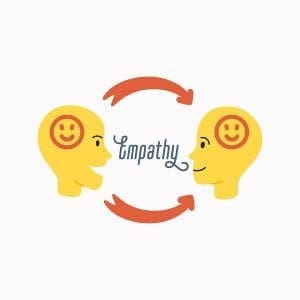 Pleasingly, there would appear to be an uplift in the amount of airtime around the topic of empathy within the context of service. It began before the pandemic and is another of the rare silver linings to have grown with it. Perhaps as more of us are finding ourselves in a rather similar looking boat, it becomes easier to consider life’s ups and downs from another’s shoes.
Pleasingly, there would appear to be an uplift in the amount of airtime around the topic of empathy within the context of service. It began before the pandemic and is another of the rare silver linings to have grown with it. Perhaps as more of us are finding ourselves in a rather similar looking boat, it becomes easier to consider life’s ups and downs from another’s shoes.
Regardless of the genesis, we know that empathy is a skill, (or is it a trait, or maybe a competence?) that we should all embrace, nurture amongst our teams and build into our corporate and personal values. Service is our obsession at Penshee, and we spend a significant proportion of our time appraising service delivery. Sadly however, it remains too infrequent a moment that we feel the warm embrace of an empathetic encounter.
So what’s going on here, why the gap between talking about empathy, and exhibiting it? We’d all do well to begin by answering two fundamental questions:
‘Do we (and our teams) know exactly what empathy is?’, and ‘Do we know how, and when, to demonstrate it?’.
If the answer to each question is anything other than ‘yes’ – the pursuit of empathy can be filed away under ‘Things we talk about lots but don’t actually do’.
Allow me to use the remainder of this short article to address these questions.
When do we need to use empathy?
ALWAYS! Empathy must not be a weapon that we reserve for moments of apparent emotional import. As with any other positive traits such as kindness, compassion, open-mindedness or humour, empathy should always be switched on. It is up to us to regulate these traits and bring them into play according to the emotional landscape of the present moment. Empathy is no different, it should not be reserved for apparently ‘weighty’ situations which result in polarised emotions, such as mourning, aggrievance, sadness, stress, agitation, or perhaps elation or joy. Indeed, and perhaps thankfully (empathy fatigue is real and happens to many professionals most notably, healthcare practitioners), it’s unusual for customers to expose such openness to a complete or near stranger. However, tiny opportunities to demonstrate empathy arise in every single interaction, but first we’ll need to know exactly what empathy is.
Empathy is….
We can all have a bit of a stab at defining empathy and will probably land quite close to one of the three widely recognised types – namely cognitive, emotional and compassionate. By all means, look them up, it is interesting, but for now, please allow me to share our own definition, created with hospitality and service in mind. Why? As with so many things that companies set out to deliver to their customers, such as ‘exceeding expectations’, ‘wow moments’, ‘going the extra mile’ etc. etc., we need to make sure that we aren’t making the mistake of targeting something that sounds right, and is a decent place to get to, but is simply not understood by those on the front line of service. This is the quandary from which spawned our definition of empathy, relevant to the service industry.
Reading the verbal and non-verbal cues of a guest and responding to them in a way that demonstrates understanding of the level of importance attached to the message.
If your knee jerk reaction to this definition is to question its clinical nature, I’d look to reassure you that in being this way, it will be of greater practical use. Whilst service should be understood in the language of feelings and emotion, it should always be translated into robust and deliverable terms.
“Okay, I’m listening, but how do we make it happen?”
Let’s start with reading guests. It’s hard to distill a plethora of behavioural science-based research into simple tips and the reality is, you will need to invest time and energy into the process (come on, you know there’s no such thing as a behavioural quick fix!). However, some foundational advice at this stage would be to look to find ways to create the space necessary to ensure that employees can be fully present during interactions. Only when they have sufficient, distraction-free time to spend with the customer, can they begin to really tune in to not just their words, but more importantly, their body language, tone of voice and other non-verbal modes of communication.
Focus on developing, not demonstrating empathy
Authentic care is vital to the process of effective communication, in that it is only when the customer’s experience is truly the priority of the employee that they will switch from the mode of transaction and compliance, to the landscape of curiosity and compassion. This is where we see the crucial flip from reflexively saying what you think somebody wants to hear, to creating the space for them to communicate more. The former will close the conversation, and likely lead to an interaction that felt transactional or perfunctory. The latter uses curiosity to open the doorway to empathy and understanding. One cannot simply demonstrate empathy, we must develop it first.
So how do we develop it?
One of the reasons that I generally buck the parenting 101 of teaching children not to talk to strangers, is that we want our children to be empathetic, and curiosity is known to be a dominant trait amongst empathetic people. The vehicle of curiosity is listening and the vital importance of unencumbered listening cannot be overstated. Active listening needs to be elevated from its lowly one-hour slot in an annual ‘service excellence’ training session, to an integral part of a company’s culture. As with anything that you expect to achieve for your customers, it needs to be happening throughout your organization. To have one set of behaviours for customers, and another for employees, is the way of fools.
“The most basic of all human needs is the need to understand and to be understood. The best way to understand people is to listen to them.” – Ralph G Nichols
Still curious? Excellent.
Once the necessary space is created and listening and curiosity skills can thrive, you’re in a good place to be able to communicate that understanding – in fact some of it will have started permeating the interaction subliminally already, through subtle shifts in your body language, tone of voice and even inflexions in facial expression. You will further demonstrate understanding by attaching the right level of importance to what is being communicated. The words themselves give us context only. Non-verbal communication will determine the level of significance that the individual holds to the point in question and how, therefore, you should best respond – perhaps with sympathy, humour, surprise, affirmation, delight or even flippancy. It is this level of detail that needs to be communicated and understood when training your teams.
What do I do first?
I get it, there’s a lot in here to take on board but if you’ve got this far, it’s clear that you want to bring a greater level of empathy into your working life. I’d start by sharing the article with a colleague or friend, and taking the time to scrutinise it with them. If it stands up, and you want to start putting wheels into motion, look to gain a better understanding of the existing levels of empathy, curiosity and listening amongst your employees. Walk the floor, observe, listen-in and talk to as many people as possible. If you aren’t feeling it, it’s not there. Whilst you’re at it, start trying to understand how much ‘space’ your teams have. Are they present and focused, or are they constantly playing catch up and exhibiting signs of stress? If you’re serious about building empathy, these are the things you’ll need to overcome first. From there, take a definition (borrow ours, or create your own in a focus group perhaps) and make sure that you translate it well, for all to understand. It is not, and should not be, a quick fix but it should, and will be an enjoyable and deeply rewarding process, with the right attitude behind it.
Thank you for being curious, and needless to say, if our phone rings and you are on the other end, we are all ears!


















